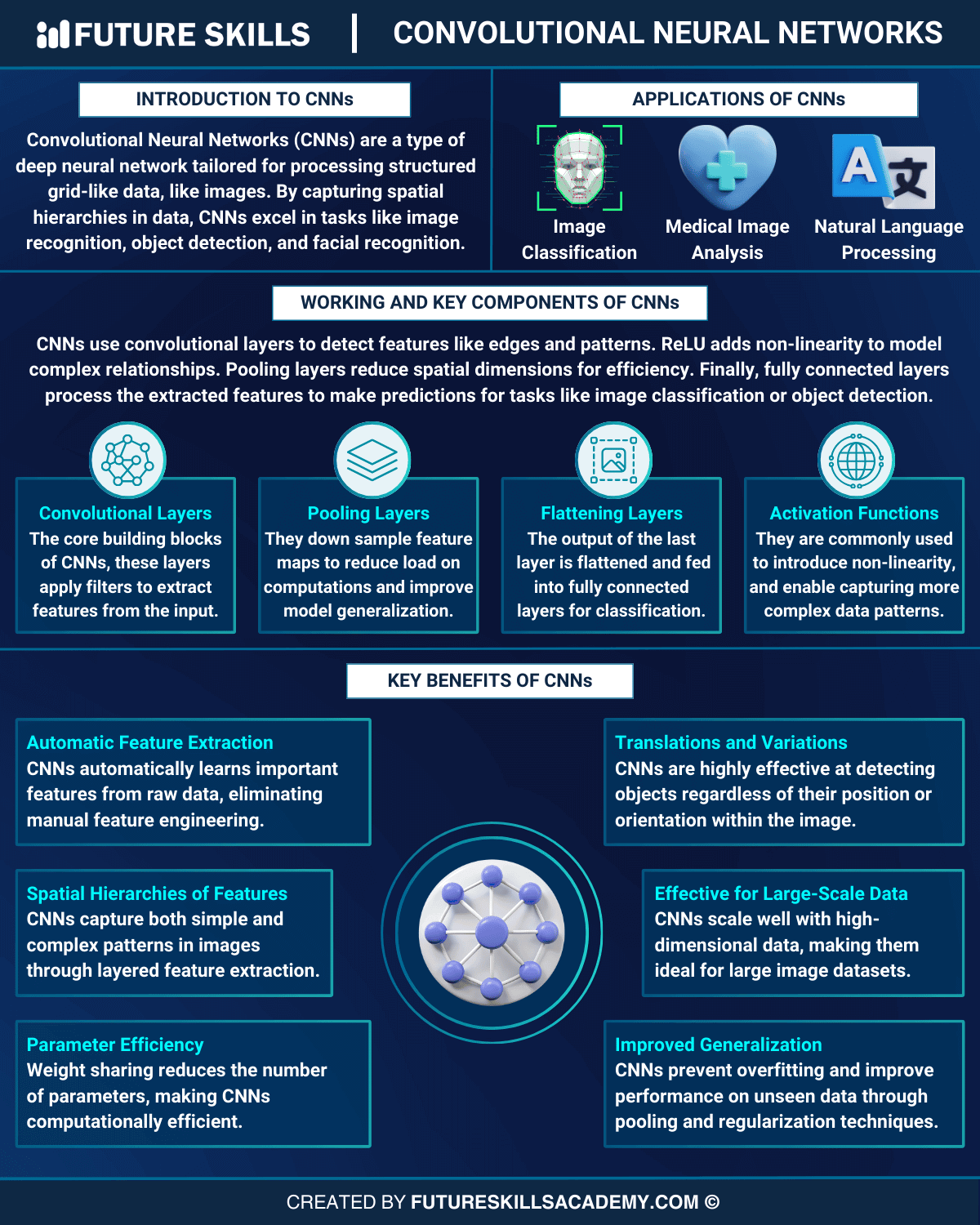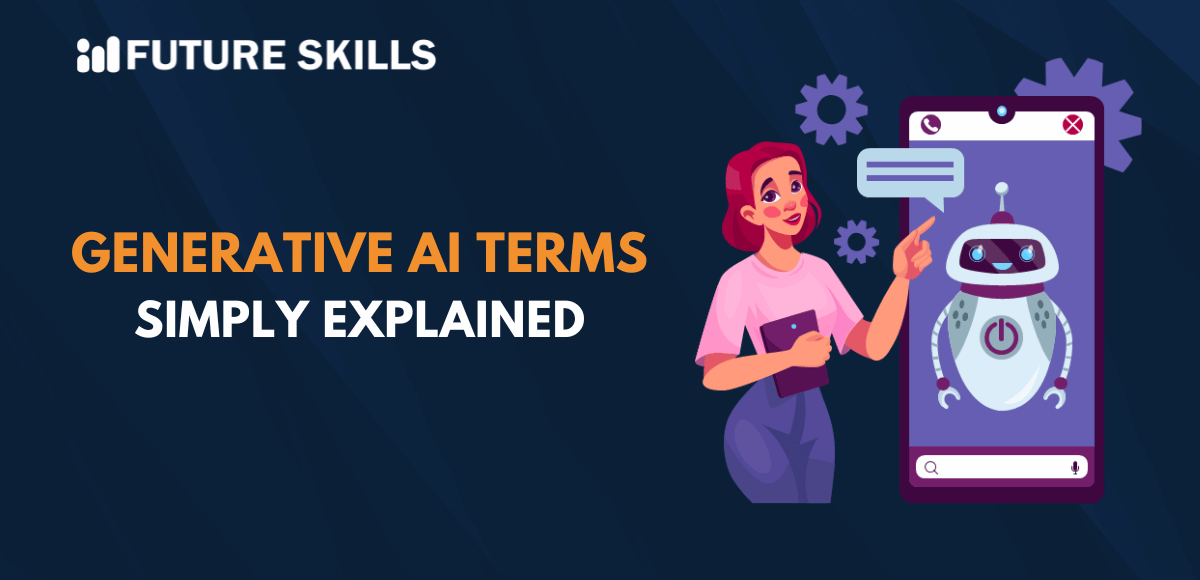Neural networks have established the foundations of deep learning by mimicking the working of the human brain. You can find different types of neural networks tailored for distinct use cases that work with different types of data. Recurrent neural networks are the ideal choices for speech recognition and natural language processing tasks.
When it comes to image processing tasks, convolutional neural networks CNNs are the most effective solutions. CNNs enable computer vision and classification tasks without the time-consuming methods for feature extraction, thereby enhancing scalability for object recognition and image classification tasks. Let us learn more about the architecture of convolutional neural networks and their practical applications.
Become a job-ready prompt engineering expert with our accredited Prompt Engineering Certification Program. Enroll today!
Understanding the Inspiration behind Convolutional Neural Networks

Convolutional neural networks are special deep learning algorithms tailored for object recognition tasks such as image segmentation, classification and detection. CNNs can be used in a wide range of practical applications including security camera systems and autonomous vehicles. Convolutional neural networks work by using principles of linear algebra, such as matrix multiplication, for identifying patterns in images. While convolutional neural networks reduce the time required for image classification and object recognition tasks, they require significantly higher computing power.
Another important aspect in answers to queries such as ‘What is CNN convolutional neural network?’ focuses on their importance in the modern world. Convolutional neural networks are different from classic machine learning algorithms like decision trees and support vector machines. They enable autonomous feature extraction on a large scale by removing the need to depend on manual feature engineering. The convolutional layers in the architecture of CNNs support extraction of features and patterns from data without depending on variations in translation, position, scale and orientation.
Convolutional neural networks can be used in many other domains beyond image classification tasks. Many pre-trained CNN architectures such as EfficientNet, ResNet50 and VGG-13 have showcased top-tier performance with better adaptability to new tasks through fine-tuning. The versatility of CNNs makes them an essential element in the domain of deep learning. Some of the notable applications of CNNs include speech recognition, natural language processing, and time series analysis.
Unraveling the Relationship between CNNs and the Human Brain
The primary inspiration behind the design of convolutional neural networks is the human brain. The design of convolutional neural networks architecture is similar to that of the visual cortex albeit with some setbacks. For instance, CNNs don’t have the complex feedback mechanisms found in the human visual system. Convolutional neural networks also rely on supervised learning instead of unsupervised learning. You can find similarities between CNNs and the visual cortex in terms of architecture, connectivity and non-linearity.
Convolutional neural networks have the same hierarchical structure as the visual cortex that works by extracting simple features in early layers and the complex features in deeper layers. The architecture enables the generation of sophisticated representations of visual inputs. Neurons in a layer of CNNs are connected to a local region of input volume like the neurons in the visual cortex. The local connectivity offers the assurance of better efficiency.
Convolutional neural networks showcase non-linear response properties like the neurons in the visual cortex through activation functions. Neurons in the visual cortex extract different feature maps at different stages of visual processing. CNNs can replicate the same behavior by using multiple filter maps in the convolution layers.
Discovering the Components in Convolutional Neural Networks
You can identify the similarities between the architecture of convolutional neural networks and the visual cortex by learning about the role of their individual components. The components that power the uses of convolutional neural networks in deep learning help them recognize features and patterns in images like the human brain. The four important components of CNNs include convolutional layers, fully connected layers, activation function and pooling layers. Let us find more about the importance of each component in the following sections.
-
Convolution Layers
The convolution layers are the first component in the architecture of convolutional neural networks. They help in adding a sliding window function to a matrix of pixels that represent an image. The sliding function implemented in the matrix is the filter or kernel. You can find multiple filters of equal size in the convolution layer with each filter capable of recognizing specific patterns in an image.
The simplest explanation for the working of convolution layers can paint the filters or kernels as small grids hovering over an image. Every small grid serves as a magnifying glass for identifying specific patterns such as lines, shapes or curves in an image. Interestingly, the grid creates another grid that showcases the location of the patterns as it moves through the image. Convolutional neural networks use different types of grids to obtain a clear impression of different patterns within the image.
Another crucial element in any convolutional neural network example is the kernel used in the convolution process. The kernel is a 3×3 dimension in which weight of each element is represented through the grid. Black grids represent zero weights while the white grid represents the ones. In practical scenarios, the training process of the neural network helps in determining the weights of kernels.
-
Activation Function
Activation functions are an integral component required for the functionality of neural networks. Convolutional neural networks use a ReLU or Rectified Linear Unit function after every convolution process. The activation function is useful for learning non-linear relationships between features and patterns in the image. ReLU not only makes the convolutional neural network more capable of identifying different features and patterns but also reduces vanishing gradient issues.
-
Pooling Layer
Another important component in the architecture of convolutional neural networks is the pooling layer. It focuses on extracting the most important features from the convolution matrix through aggregation operations. The aggregation operations help in reducing the dimension of the convolution matrix or feature map, thereby reducing the memory required for training the network.
You must also remember that pooling is essential for reducing overfitting. Some of the common aggregation functions applied in CNNs include max pooling, average pooling and sum pooling. Max pooling refers to the maximum value of a feature map while average pooling refers to the average of all values. Sum pooling, as the name implies, is the sum of all values in the feature map. Another important highlight of the pooling layer is that the last pooling layer flattens the feature map for easier processing by the fully connected layer.
-
Fully Connected Layers
Fully connected layers are the last component of convolutional neural networks. The input for fully connected layers is the flattened feature map or one-dimensional matrix generated in the last pooling layer. It is important to remember that convolutional neural networks or CNNs apply ReLU activation functions to the fully connected layers to achieve non-linearity. The fully connected layers also include the softmax prediction layer that helps in generating probability values for expected output labels. The label with the highest probability score emerges as the final output label in the predictions.
Develop better understanding of working mechanism of neural networks by learning about the anatomy of a Neural Network in detail.
Identifying the Practical Uses of Convolutional Neural Networks
Convolutional neural networks have a broad range of applications, particularly in the domain of computer vision. Computer vision enables computers to extract relevant information from images, videos and other visual data. The most interesting aspect of the applications of CNNs in computer vision tasks is the ability to offer recommendations which are different from simple image recognition tasks. You can find practical applications of convolutional neural networks in the following areas.
-
Image Classification
Convolutional neural networks are useful for image categorization in which images can be assigned to pre-determined categories. One of the use cases of image categorization is the automatic arrangement of photos on social media platforms.
-
Facial Recognition
Facial recognition is also another important application of convolutional neural networks with a broad range of use cases. You can find the best example of CNNs in facial recognition systems with security systems that offer efficient access control on the basis of facial features.
-
Object Detection
Convolutional neural networks have the capability for identifying and locating multiple objects in an image. The object detection capability of CNNs is useful in various scenarios in the retail industry, including shelf scanning to identify items that are running out of stock.
CNNs can revolutionize many industries with these applications. The examples of convolutional neural networks in healthcare focus on the use of computer vision in radiology to identify tumors. Computer vision can also improve the safety of passengers and drivers through lane detection capabilities. As convolutional neural networks evolve further, they may introduce new use cases across various industries.
Learn how to make the most of ChatGPT in your daily lives and become more productive with our Certified ChatGPT Professional (CCGP)™ Course.
Final Thoughts
The insights on fundamentals of convolutional neural networks showcases their importance in the deep learning landscape. You must note that CNNs work exactly like the human visual cortex to identify images and the patterns or features in them. The similarities between convolutional neural networks architecture and the human visual system represent the sophistication of CNNs. For example, CNNs have a hierarchical structure and exhibit non-linearity like the human visual cortex.
The applications of convolutional neural networks in autonomous vehicles, smart security camera systems and retail shelf scanning establish the foundation for more enhanced applications. Learn more about convolutional neural networks and their working mechanism right now.







